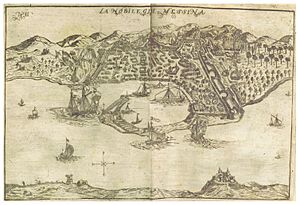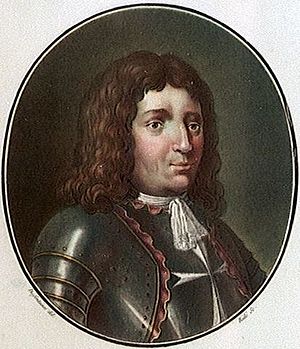Messina revolt facts for kids
The Messina revolt was a big uprising that happened in the city of Messina, Sicily, between 1672 and 1678. It started when skilled workers in Messina rebelled against the rich families who ran the city. Later, these rich families joined the fight, but they turned it into a rebellion against Spain, who ruled Sicily at the time. Messina got help from France and was independent for a while. But when the Franco-Dutch War ended in 1678, Spain took control of Messina again.
Contents
Why the Revolt Started
In the mid-1600s, Messina was a large city with about 120,000 people. A few rich families, called "patricians," controlled the city council.
Spain, which ruled Sicily, gave Messina a special right in 1663. This right meant Messina was the only city allowed to export silk. But other Sicilian ports complained loudly. So, Spain took away this special right the very next year. This made the rich and powerful people in Messina very unhappy with the Spanish rulers.
The Spanish leader, Captain-General Luis de Hojo, tried to cause trouble between the common people and the rich families. He tried to make it look like the city leaders were to blame for problems, like food shortages.
In 1672, the skilled workers in Messina rebelled. They forced the rich patrician families out of power. At first, they were not fighting against Spanish rule itself. The Spanish Viceroy of Sicily, the Prince de Ligne, was worried by these problems. He had Luis de Hojo removed from his job. When the unrest continued, the Prince de Ligne also resigned.
Messina Fights for Freedom
On July 7, 1674, the trade companies and the rich families of Messina joined forces. They started a revolt against Spain. They surrounded Captain-General Crispano in his palace. The rebels drove out the Spanish soldiers and took control of almost the entire city. They captured four out of five forts.
Messina then asked for help from France. They sent messengers to the French ambassador in Rome and to Admiral Louis Victor de Rochechouart de Mortemart, who was on the coast of Catalonia.
French Help Arrives
On September 27, 1674, a French admiral named Jean-Baptiste de Valbelle arrived to help the rebels. He brought supplies on seven warships and three fire ships. Valbelle bravely sailed into the city's harbor, bringing enough food for about five weeks. He also helped the people of Messina kick the Spanish out of their last fort, the Faro, which was at the harbor entrance. Since he didn't have enough soldiers or supplies to fight the Spanish on land, Valbelle left to get more help.
On January 1, 1675, Valbelle's ships returned. This time, they brought a small group of soldiers led by Lieutenant-General Valavoire. The French king, Louis XIV, wanted Messina to become an independent country or join France.
When the French arrived on January 2, 1675, the Spanish army was camped outside Messina. They had taken back some forts and seemed ready to capture the city. The Spanish also had a large fleet of 22 ships and 19 galleys blocking the entrance to the Strait of Messina. Valbelle, with only six warships and three fire ships, bravely sailed through the Spanish blockade and entered the port safely on January 8.
Even though the Spanish troops moved away from the city, Valavoire didn't have enough soldiers to move inland. Soon, food supplies became low again.
Another French fleet, led by Capitaine de Tourville, arrived. He joined Valbelle, but their combined force was still not strong enough to attack the Spanish fleet. Then, Admiral Vivonne himself arrived on February 11, 1675, with eight more warships. The French fleet now had 20 warships.
The French easily defeated the Spanish in a battle near the Lipari Islands. They captured a Spanish warship. Vivonne was then able to sail into Messina, bringing lots of food. For the rest of 1675, France sent more ships and soldiers to Sicily and southern Italy.
In 1676, a Dutch fleet, led by Michiel de Ruyter, tried to block Messina. They fought a French fleet in the battle of Stromboli in January 1676. Later, de Ruyter was badly wounded in the Battle of Augusta in April. The Dutch and Spanish ships had to leave Messina. Even though the French stopped the blockade, most of their fleet was called back to France later that year. The French soldiers left Messina in early 1678.
Spain Takes Back Control
On January 10, 1678, England and the United Provinces (now the Netherlands) signed a peace treaty. King Louis XIV of France realized he couldn't fight against the combined English and Dutch navies. He decided to pull his troops out of Sicily. He had always seen Sicily as a side project.
He sent François d'Aubusson de La Feuillade from Toulon with a fleet. La Feuillade was supposed to replace Vivonne as the leader in Sicily, but his real mission was to take the French soldiers away. On February 28, 1678, La Feuillade announced himself as the new leader with a grand ceremony.
On March 13, 1678, he loaded the French soldiers onto ships, pretending they were going on a mission to Palermo. Then, he told the leaders of Messina that the French were leaving for good. A few hundred leading families were allowed to get on the ships before the fleet sailed away. The Spanish leader returned to Messina without any fighting. He had promised to forgive everyone who had rebelled, but he did not keep this promise.
Images for kids






